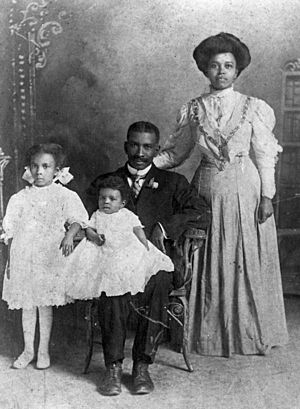African Americans in Florida facts for kids

African American family in Gainesville, Florida.
|
|
| Total population | |
|---|---|
| 3,337,159 (2014) | |
| Regions with significant populations | |
| North Florida and Miami metropolitan area | |
| Languages | |
| Southern American English, African-American Vernacular English, Haitian Creole, Jamaican Patois, Cuban Spanish, Gullah, Afro-Seminole Creole, Miami English, Caribbean English | |
| Religion | |
| Christianity, Haitian Voodoo, Black Protestant, Evangelical Protestant, Black Catholicism, Jehovah's Witness, Irreligion, Santería | |
| Related ethnic groups | |
| Afro-Cubans, Afro-Caribbeans, Black Seminoles, Gullah, West Indian Americans, Black Hispanic and Latino Americans |
African Americans in Florida are people living in Florida who have African family roots. They are also called Black Floridians. In 2010, about 16.6% of Florida's population was African American. Black people have been in Florida since the early 1700s. Many were enslaved people who escaped from Georgia into Florida's swamps. Others were brought to Florida by Spanish explorers.
Contents
History of Black Floridians
The story of Black people in Florida goes back a long way. It even starts before the United States was formed. In 1513, a Congolese-Spanish explorer named Juan Garrido arrived. Later, in 1528, the enslaved Afro-Spanish explorer Estevanico came. In 1565, both free and enslaved African people landed in what would become St. Augustine, Florida.
Early Beginnings
The first Black town in Florida was Fort Mose. It was a military outpost for free Black settlers near St. Augustine. Many Black people came to St. Augustine because Spanish Florida promised freedom. This was for enslaved people who escaped from the British colonies in North America. They gained freedom if they served in the military.
Later, the British took control of Florida. This ended the Spanish era. Many Spanish people, including Black residents, moved to Cuba. After this, enslaved African Americans became the main Black population in Florida.
After the Civil War
After the American Civil War, there was a short period called Reconstruction (1867 to 1877). During this time, laws were made to protect the rights of African Americans. But this era ended suddenly in 1877.
After Reconstruction, policies changed. The rights of Black people were no longer protected. Black voters and politicians faced threats from some white groups. Because of this, Black people lost many of their new freedoms.
Fighting for Rights
Between 1900 and 1930, Florida had a very high rate of violence against Black people. Even when attackers were known, they often faced no legal action. A turning point came in 1951 with the Murder of Harry and Harriette Moore. The FBI was asked to help investigate. The KKK was suspected, but there was not enough proof for a trial. This violent time was followed by continued segregation.
Florida Governor LeRoy Collins believed that segregation was wrong. Then, the federal Civil Rights Act was passed in 1964. This law helped end segregation. Schools began to allow students of all races, though this was not always easy.
Afro-Cubans in Florida
In the 1880s, there was an Afro-Cuban community in Tampa and Ybor City. Afro-Cubans were separated from white Cubans. They were also different from African Americans because of their language, culture, and religion. Afro-Cubans faced unfair treatment in Florida because of their skin color.
Population Changes
In 2010, people of African heritage made up 16.0% of Florida's population. This group includes African Americans. About 4.0% (741,879 people) were of West Indian or Afro-Caribbean background. In the early 1900s, Black people were nearly half of Florida's population.
Many African Americans moved away from Florida. They left because of segregation, losing their right to vote, and problems with farming. This movement is called the Great Migration. It happened in waves from 1910 to 1940, and again after the 1940s. They moved to northern cities to find jobs. They also wanted better schools for their children. And they wanted the chance to vote and be a full part of society.
By 1960, the number of African Americans in Florida had dropped to 18%. At the same time, many white people from the North moved to Florida. Today, many Black residents live in northern and central Florida. Besides those whose families were enslaved in the U.S. South, Florida also has many Black people from the West Indies, Africa, and Latin America. These groups are especially common in the Miami/South Florida area.
Notable People
Many important African Americans have lived in Florida. Here are a few:
- James Weldon Johnson (1871–1938)
- Mary McLeod Bethune (1875–1955)
- Zora Neale Hurston (1891–1960)
- Augusta Savage (1892–1962)
- Thelma "Butterfly" McQueen (1911–1995)
- Jackie Robinson (1919–1972)
- Sidney Poitier
- George "Buster" Cooper (1929–2016)
- Peggy Quince (born in 1941)
- Angela Bassett (born in 1958)
- Emmitt Smith (born in 1969)
- Maya Rudolph (born in 1972)
- Eric Darius (born in 1982)

